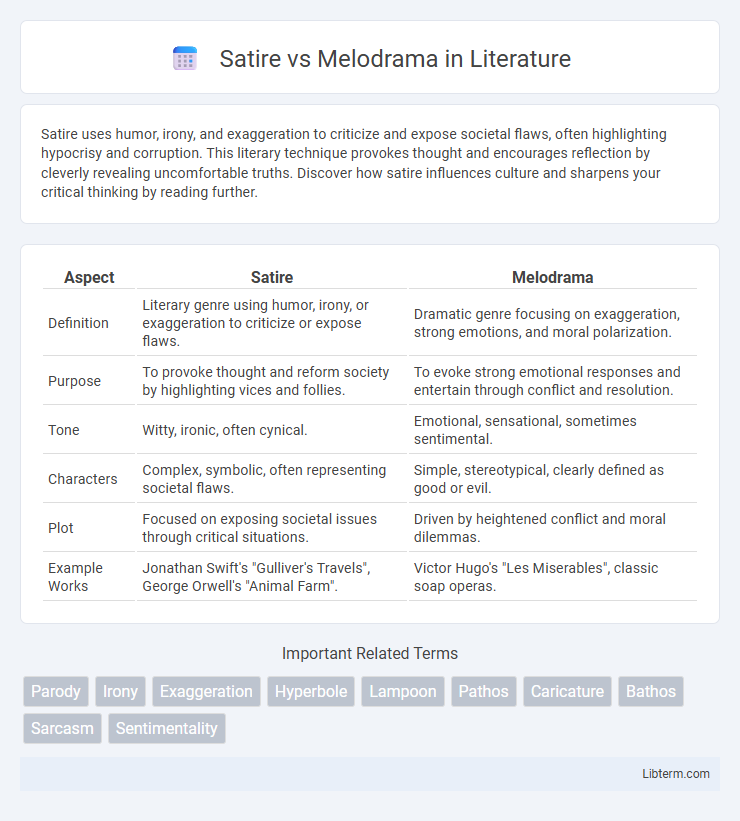Satire uses humor, irony, and exaggeration to criticize and expose societal flaws, often highlighting hypocrisy and corruption. This literary technique provokes thought and encourages reflection by cleverly revealing uncomfortable truths. Discover how satire influences culture and sharpens your critical thinking by reading further.
Table of Comparison
| Aspect | Satire | Melodrama |
|---|---|---|
| Definition | Literary genre using humor, irony, or exaggeration to criticize or expose flaws. | Dramatic genre focusing on exaggeration, strong emotions, and moral polarization. |
| Purpose | To provoke thought and reform society by highlighting vices and follies. | To evoke strong emotional responses and entertain through conflict and resolution. |
| Tone | Witty, ironic, often cynical. | Emotional, sensational, sometimes sentimental. |
| Characters | Complex, symbolic, often representing societal flaws. | Simple, stereotypical, clearly defined as good or evil. |
| Plot | Focused on exposing societal issues through critical situations. | Driven by heightened conflict and moral dilemmas. |
| Example Works | Jonathan Swift's "Gulliver's Travels", George Orwell's "Animal Farm". | Victor Hugo's "Les Miserables", classic soap operas. |
Understanding Satire: Definition and Key Features
Satire is a literary genre that uses humor, irony, exaggeration, or ridicule to expose and criticize societal flaws, aiming to provoke thought and reform. Key features include wit, sarcasm, parody, and a critical tone that targets human vices, political corruption, or cultural absurdities. Unlike melodrama's emotional exaggeration, satire relies on intellectual engagement and subtlety to challenge audiences.
What is Melodrama? Core Elements Explained
Melodrama is a dramatic genre characterized by exaggerated emotions, clear moral distinctions, and often sensationalized plotlines designed to appeal to the audience's emotions. Core elements include stereotypical characters, such as the virtuous hero and villainous antagonist, a predictable storyline with high emotional stakes, and music or visual cues that heighten the emotional experience. Unlike satire, which uses humor and irony to critique society, melodrama focuses on eliciting emotional responses through intense, straightforward storytelling.
Historical Origins: Satire and Melodrama Across Time
Satire originated in Ancient Greece and Rome as a literary form used to critique society, politics, and human vices through humor and irony, with figures like Aristophanes and Juvenal as early practitioners. Melodrama emerged in the 18th century during the Romantic period, emphasizing exaggerated characters and emotional appeals to engage audiences, often showcased in theatrical productions and later adapted by early cinema. Both genres evolved across centuries, reflecting societal values and artistic trends, with satire maintaining a critical edge while melodrama prioritized emotional storytelling.
Tone and Intent: Contrasting Approaches
Satire employs a tone of irony, sarcasm, and humor to critique social, political, or cultural issues with the intent to provoke thought and inspire reform. Melodrama features an exaggerated, emotional tone aimed at evoking strong feelings such as sympathy or anger, often emphasizing moral polarization and sensationalism. The intent behind satire is to encourage critical reflection, while melodrama seeks to engage audiences through heightened emotional experiences.
Characterization: Archetypes in Satire vs Melodrama
Satire employs archetypes such as the fool, the hypocrite, or the corrupt official to exaggerate human flaws and societal vices, using these characters as vehicles for critique and humor. Melodrama relies on clear-cut archetypes like the virtuous hero, the damsel in distress, and the villain, emphasizing emotional extremes and moral polarity to engage the audience's empathy and drive the plot. Characterization in satire often subverts traditional archetypes to provoke thought, while melodrama maintains conventional roles to elicit strong emotional responses.
Plot Structure: Irony vs Exaggerated Emotion
Satire employs a plot structure rich in irony, where events and dialogues often convey meanings opposite to their literal sense, highlighting societal flaws through wit and critical reflection. Melodrama relies on exaggerated emotion and clear moral opposites, typically following a linear plot with heightened conflicts designed to evoke strong audience empathy and emotional response. The contrast between satire's nuanced verbal irony and melodrama's overt emotional exaggeration shapes distinct narrative techniques and audience engagement strategies.
Techniques and Devices: Tools of Each Genre
Satire employs irony, parody, and exaggeration to critique societal flaws through wit and humor, often utilizing sarcasm and juxtaposition to highlight absurdities. Melodrama relies on heightened emotions, stereotypical characters, and sensational plot devices, such as moral polarization and dramatic music cues, to evoke strong emotional responses. Both genres use symbolism and narrative structure strategically, but satire aims to provoke thought while melodrama seeks emotional engagement.
Social Commentary: Satire’s Critique vs Melodrama’s Appeal
Satire employs irony, exaggeration, and humor to critically expose societal flaws, prompting reflection and reform through sharp social commentary. Melodrama appeals to emotions by dramatizing moral conflicts and personal struggles, often reinforcing traditional values without directly challenging social norms. While satire provokes awareness by highlighting hypocrisy, melodrama engages audiences through emotional resonance and moral clarity.
Impact on Audiences: Perception and Reception
Satire sharpens audience perception by using humor and irony to critique societal flaws, prompting reflection and critical analysis. Melodrama intensifies emotional reception through exaggerated characters and situations, generating strong empathy and visceral responses. These contrasting approaches shape audience engagement, with satire fostering intellectual discourse and melodrama eliciting visceral emotional connections.
Blending Genres: Modern Works Combining Satire and Melodrama
Modern works often blend satire and melodrama to create layered narratives that critique social norms while engaging audiences emotionally. This fusion exploits satire's sharp wit and irony alongside melodrama's heightened emotional stakes, exemplified in shows like "BoJack Horseman" and films such as "Fleabag." By combining these genres, creators deepen character complexity and amplify thematic impact, challenging viewers to reflect on cultural hypocrisies within emotive storytelling frameworks.
Satire Infographic

 libterm.com
libterm.com